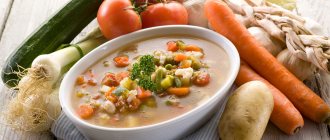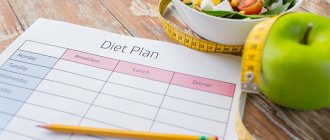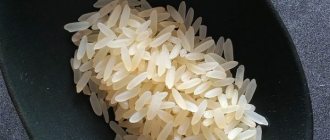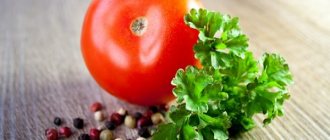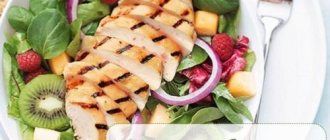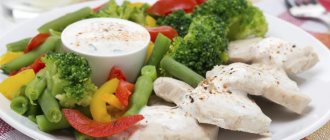The essence of the technique
First of all, a protein diet should not be mixed with a ketogenic diet. On a ketogenic diet, the body is almost completely deprived of carbohydrates, and the body, in conditions of deprivation of the brain of glucose, enters a state of ketosis, switches to feeding on ketones, byproducts of the destruction of fat tissue and an alternative source of nutrition for the brain (which first of all reduces intellectual abilities).
Of the 20 amino acids into which proteins are broken down during digestion, 15 are glucogenic, they can be converted into glucose and glycogen, 3 ketogenic amino acids can be converted into ketone bodies, and 2 are both glucogenic and ketogenic.
To keep the body in a state of ketosis, the daily amount of protein should not exceed 1.8 g per 1 kg of weight; on protein diets such a restriction is not set, but the total amount of protein is limited by a much lower calorie diet.
If the calorie content of a ketogenic diet for weight loss is usually 1800 kcal, then a protein diet is about 700 kcal. In a state of ketosis, the main component of nutrition is fats, making up about 75% of the calorie intake, while on a protein diet, fats are limited. Often, when choosing a diet, those losing weight lean towards the ketogenic diet precisely because of its higher calorie content and more significant results in losing weight.
Nutritionists have developed various options for protein diets, differing in duration of 7, 14 days and a month.
The 7-day diet is usually used as the final stage of a long-term low-calorie balanced diet, solely for the purpose of “strengthening” the result (for which you then have to pay for the need to restore not only the decreased basal metabolism, but also carbohydrate metabolism).
Protein diets for 14 days and a month have effective results, and a choice is usually made between them. Staying on a protein diet for more than 4 weeks is contraindicated.
Recipes for a protein diet
All recipes are easy to prepare and include a small number of ingredients. Add seasonings as you wish, but only a little, otherwise the spices may whet your appetite. Ready-made meals should be salted to a minimum, because salt retains water in the body, thereby losing weight slowly. Vegetables, fresh, stewed, baked or steamed, are ideal as a side dish.
Boiled chicken breast
The most popular dish for those losing weight on a protein diet is chicken. Some people mistakenly believe that after cooking it turns out dry and tasteless, but this is not so, you just need to cook the breast correctly.
Compound:
- 450-500 g chicken fillet (breast can be used);
- 2.5-3 liters of water;
- one head of onion;
- 2 garlic cloves;
- 2 bay leaves;
- 3-4 peas of black allspice;
- a bunch of greens (parsley, dill).
How to cook:
Remove the husk from the onion and cut the head itself into four parts. Peel the garlic cloves and cut into thin slices. Finely chop the washed greens with a knife.
Bring water to a boil in a saucepan. After boiling, pour in the greens, chopped onion, chopped garlic, peppercorns, and bay leaves. Reduce heat to minimum level.
Separate the skin from the breast and trim off excess fat. If you are using fillet for cooking, cut it into small cubes. Pat the pieces dry with a paper towel and place them in the vegetable broth.
Continue to simmer over low heat for no more than 5 minutes. When foam forms, remove with a slotted spoon. When the time is up, remove the pan from the heat, cover the contents with a lid and leave to cool at room temperature.
In half an hour the meat will be ready, it will retain all its beneficial qualities and will not lose its juiciness. Remove the fillet from the broth and serve with a fresh vegetable salad.
On a note!
Do not pour out the remaining broth; it will still be useful for cooking first courses.
Boiled beef
If you don’t have time to cook every day, boil a piece of beef and divide it into several equal parts. Boiled meat will quietly lie in the refrigerator for at least 3-4 days, while the taste and benefits are preserved.
Compound:
- 500-600 g lean beef;
- one carrot;
- one small onion;
- a couple of bay leaves;
- 2 black peppercorns;
- a bunch of greens (parsley with dill).
How to cook:
Peel the carrots, cut into small pieces 1-2 cm thick. Chop the garlic and herbs, and divide the onion into 4 equal parts. Transfer the prepared vegetables to a saucepan, add peppercorns and bay leaves. Pour about 3-3-.5 liters of water and put on fire.
After the water boils, transfer the meat into it and immediately reduce the heat. Beef takes at least 2 hours to cook, but cook longer until the meat fibers are tender. Skim off the foam from the broth periodically.
When the beef is ready, remove the pan from the heat and leave the contents to cool. Remove the meat from the broth, cut into slices or strips as you like and serve for lunch. Bon appetit!
Chicken liver in yogurt
For variety, include chicken by-products in your menu. This is an excellent source of protein and is also very healthy. To make the dish soft, add a dairy product, such as sour cream or low-fat yogurt.
Compound:
- 300-350 g chicken liver;
- 2 onions;
- glass of water;
- a glass of low-fat yogurt;
- salt, pepper to taste.
How to cook:
Remove the husks from the onion, cut into thin half rings, and place in a cup. Wash the chicken liver, remove any remaining bile, otherwise the taste will be bitter. Cut off the veins and fat with a knife. If the offal is large, cut into 2 halves.
Pour a little oil into the frying pan, and if the surface is non-stick, you don’t have to add anything. As soon as it warms up, add the prepared liver. Fry it over high heat for at least 2-3 minutes, stirring occasionally. When the pieces begin to brown, pour in a glass of water, cover the pan with a lid and simmer for at least 10 minutes over medium heat.
Add onion rings, stir, cover again and continue cooking for another 5-7 minutes. Then add salt and pepper, and after another 5 minutes, pour yogurt over everything and mix everything well again. After 10 minutes, turn off the heat.
Before serving, sprinkle the dish with finely chopped herbs; you can squeeze out a garlic clove for flavor. Crumbly buckwheat porridge is suitable as a side dish, but no more than 2-3 tablespoons.
Advice!
If you bought frozen liver, be sure to wait until the product thaws. Do not defrost in the microwave as this will make the dish dry.
Cheese casserole
A casserole is perfect for breakfast or dinner. To prepare it, you will need low-fat or low-fat cottage cheese, so when purchasing in a store, pay attention to the label. 100 g of the finished product contains 120-140 kcal.
Compound:
- 250-300 g low-fat cottage cheese;
- 2 chicken eggs;
- 2 tbsp. sweetener;
- salt - on the tip of the knife;
- a pinch of vanilla;
- tsp orange zest.
How to cook:
First mash the cottage cheese with a fork and then rub through a fine sieve into a cup to obtain a homogeneous mass. Break the chicken eggs into a bowl, mix, add sweetener and zest. If you have berries (lingonberries, blueberries, cranberries), add a couple of tablespoons.
Pour the mixture into the baking dish, level it with a spoon, and then tap on the sides so that the mixture fills all the voids. Turn on the oven at 180 degrees, place the pan in it and bake for 30-40 minutes.
When the top is browned, the dish is ready. Remove the pan from the oven, cut the casserole into pieces, and garnish with fresh mint leaves and berries before serving. Bon appetit!
Rules
Recommendations for a protein diet menu for 14 days are quite simple:
- 6 meals a day;
- ban on sweets and alcoholic drinks;
- 1.5-2 hours before bedtime, a glass of tea, juice or fermented milk drink, after which food is no longer taken;
- products are chosen mainly low-fat;
- between meals (per day) you need to drink 6-8 glasses of clean still water.
There are no strict menu requirements for a protein diet for two weeks, provided the above recommendations are followed.
Important! Substitutions of products and substitutions of diets on individual days are acceptable, but at the same time, the calorie content of the daily diet should not exceed 700 kcal.
Try to eat at the same time. Keep in mind that violating the above rules will cause stress and may lead to illness.
Menu
For convenience, the menu is presented in tabular form. Ideally, each food day is characterized by its own menu, different from the menu of other days, indicating the number of products designed for the “average” person.
If you are much larger or engage in energy-intensive sports (running, skiing), you can slightly increase the amount of products based on the results.
| Day | Breakfast | Lunch | Dinner | Snack | Dinner | 2 hours before bedtime |
| 1 | Tea coffee) | Egg Salad | Chicken breast Rice | Cottage cheese | Fish Salad | Tomato juice |
| 2 | Tea coffee) | Salad Rusk | Fish Rice | Salad | Beef | Kefir |
| 3 | Tea coffee) | Egg Fruit | Egg Salad | Salad | Beef or chicken | Tea |
| 4 | Tea coffee) | Egg Cheese | Zucchini fried in vegetable oil | Grapefruit | Salad | Apple juice |
| 5 | Tea coffee) | Salad | Fish Rice | Salad | Fruit | Tomato juice |
| 6 | Tea coffee) | Egg Salad | Chicken breast Rice | Salad | Salad | Kefir |
| 7 | Tea coffee) | Fruit | Beef | Cottage cheese | Salad | Tea |
| 8 | Tea coffee) | Salad | Chicken Buckwheat | Cheese | Salad | Kefir |
| 9 | Tea coffee) | Egg Salad | Chicken Rice | Salad | Egg Bread | Tea |
| 10 | Tea coffee) | Salad | Fish Rice | Tomato juice | Grapefruit | Kefir |
| 11 | Tea coffee) | Egg | Salad | Cheese | Fruit | Tea |
| 12 | Tea coffee) | Fruit | Beef Rice | Salad | Egg Fruit | Kefir |
| 13 | Tea coffee) | Salad | Beef Oatmeal | Orange juice | Fish Rice | Tea |
| 14 | Tea coffee) | Cottage cheese | Fish Rice | Egg | Egg Salad Bread 30 g | Tomato juice |
Beef, chicken, turkey and fish should be boiled, stewed, or baked in foil. It is better to eat chicken meat white (breast), the skin should be separated from the meat. The fish can be steamed. The weight of a serving of chicken breast is 100-150 g, fish breast 150 g, beef serving 150-200 g, cottage cheese 200 g.
Cereal side dishes are cooked in water without salt and sugar, the amount of cereal is 50 g.
Vegetable salad options:
- cabbage;
- cabbage with green peas;
- carrot;
- tomatoes, cucumbers, peppers;
- cabbage (white, red, broccoli), carrots, pepper.
The weight of the products in the salad is 150-200 g, salads are seasoned with 1 tablespoon of a mixture of sunflower or olive oil with camelina, mustard or flaxseed oil, a source of omega-3 polyunsaturated fatty acids.
If there are 2 salads on the menu on one day, be sure to prepare them from different vegetables.
Prepare a small zucchini weighing 300 g, or half a large one.
Use whole grain bread, the weight of a piece is 30 g, the weight of a cracker is 20 g. The weight of a slice of low-fat unsalted cheese is 50 g.
In the table, a fruit means 1 medium-sized apple or 1 orange (it is recommended to alternate for variety). Choose a medium-sized grapefruit.
Tea (black or green) or unsweetened coffee, only natural coffee or with chicory. Juices and kefir are consumed in an amount of 200 ml (glass).
Protein diet menu for 14 days
An approximate meal plan for 2 weeks is presented in Table 1. If desired, some products for good reasons (allergies, individual intolerance) can be replaced with similar ones.
Table 1 Meal plan for 14 days
| Day | Breakfast | Dinner | Dinner |
| 1 | Low-fat cottage cheese – 150 g | A bowl of soup with vegetables (without potatoes), 100 g low-fat yogurt | Turkey fillet baked in foil – 120-150 g |
| 2 | Boiled eggs – 2 pcs., 100 g low-fat yogurt | A small piece of fish baked with herbs, steamed broccoli | Fresh vegetable salad, 2-3 slices of low-fat cheese, 80 g boiled chicken breast |
| 3 | A glass of low-fat kefir, one hard-boiled egg | Beef (150 g), boiled (possibly with broth) with a side dish of fresh vegetables | 3 tbsp. boiled rice with 100 g boiled white fish |
| 4 | 2 egg omelette with cheese (low-fat variety) | A plate of white fish soup without potatoes | Veal stewed with vegetables – 170-200 g |
| 5 | Boiled chicken breast – 150 g | Vegetable soup with chicken broth | Steamed fish – 120-150 g, fresh tomato |
| 6 | A bowl of oatmeal on water with the addition of lingonberries or cranberries | Stewed beef liver – 120-150 g, one fresh cucumber | Carrot puree, a glass of low-fat kefir |
| 7 | Cottage cheese casserole – 150 g | Steamed turkey fillet cutlets - 2 pcs., fresh cabbage and herbs salad | Fresh vegetable salad, apple |
| 8 | 120 g low-fat cottage cheese with a handful of berries | Boiled chicken breast – 120-150 g, fresh vegetable salad | Seafood baked with cheese – 120 g, fresh cucumber |
| 9 | A bowl of buckwheat porridge cooked in water | 150 g steamed white fish, cucumber and tomato salad | Grapefruit, a glass of kefir, one hard-boiled egg |
| 10 | Omelette of a couple of eggs, a glass of carrot juice | Boiled lean beef – 150 g with a side dish of stewed vegetables | Baked zucchini with cheese and chicken |
| 11 | Curd casserole – 150 g | Boiled turkey fillet – 150 g with vegetable stew | Fresh cabbage salad, glass of low-fat milk |
| 12 | 2 soft-boiled eggs, half a grapefruit | Warm vegetable salad with seafood | A glass of kefir, a sour apple |
| 13 | Vegetable salad with cheese – 200 g | Stewed cabbage with turkey – 200 g | 150 g low-fat yoghurt with a handful of sour berries, ½ orange |
| 14 | Rice porridge cooked in water without oil – 150 g, hard-boiled egg | Pink salmon baked with cheese and vegetables in the oven | 200 ml kefir, whole grapefruit |
Drinks allowed include coffee and green tea without sugar. The total amount drunk should not exceed 3-4 mugs. It is forbidden to add sweeteners (jam, honey, syrups) to porridges and yoghurts. You need to eat with a full sense of awareness, chew each piece thoroughly and take your time, then satiety will come faster.
Advice!
You cannot be distracted during a meal by talking, reading a book, watching TV or other little things. You can lose your vigilance and eat something forbidden.
Contraindications
There are contraindications for protein diets, which are more extensive than for balanced ones. Not everyone can recommend the above menu; before losing weight, you must definitely undergo a medical examination.
Protein diets are completely excluded for the following conditions and diseases:
- cardiovascular diseases, heart rhythm disturbances;
- liver diseases;
- pregnancy and breastfeeding;
- renal diseases and dysfunctions;
- joint pain and joint diseases;
- diseases of the stomach and intestines;
- elderly and advanced age (the risk of thrombosis increases).
Advantages and disadvantages
Protein diets have a number of advantages and disadvantages, some of which have already been mentioned above, but they are systematized below.
So, the advantages of a protein diet are as follows:
- Aerobic training is not contraindicated;
- there is no feeling of hunger due to prolonged digestion of protein foods;
- minimal manifestations of weakness and ailments in comparison with other diets, health, as a rule, is maintained good;
- The menu contains a sufficient amount of dietary fiber, and constipation is unlikely.
The disadvantages of a protein diet are also widely known:
- unbalanced diet;
- blood pressure is unstable and accompanied by fluctuations;
- for those who are accustomed to 3 meals a day losing weight, 6 meals a day may be unacceptable; not everyone has the opportunity to do aerobic training;
- if there is insufficient weight loss on a diet, a repeat is possible no earlier than a month after the end of the previous one;
- possible exacerbation of chronic diseases;
- the diet is depleted in vitamins, macro- and microelements, which is why it is recommended to take multivitamin and mineral complexes.
Exit
The exit from the protein diet should be gradual, also lasting about 2 weeks. Gradually introduce carbohydrates into your diet, mostly complex ones with a low glycemic index, increase the amount of bread to your usual norm, preferably whole grain, made from wholemeal flour mixed with rye flour and a sufficient amount of fiber.
Also increase the energy value of your diet, focusing on weight stability.
Important! For a protein diet to be effective for 14 days, a balanced menu should contain about 1 g of protein per 1 kg of ideal weight, about 1 g of fat per 1 kg of weight, the remaining calories come from carbohydrates (up to 4-6 g per 1 kg of weight).
With heavy physical work or intensive sports, the amount of proteins increases slightly (up to 1.2 g/kg), the main increase in calories comes from fats and carbohydrates. You should not be afraid of them, these are sources of energy for the body, and the parity of the calorie content of food with energy expenditure can be judged by the stability of weight.
Methodology for studying the effect of a high-protein diet on health
In a study published in the journal Nutrition & Diabetes, obese men (average age 50) were placed on a 1,700-kcal/day diet for a year. Half of the men adhered to a traditional diet (TC): 20% of energy came from proteins (total 88 g), and 58% from carbohydrates (total 198 g), 17% from fats (total 51 g, saturated 14 g). The other half of the men were put on a high-protein weight-loss diet (HP). The energy in this diet was distributed differently: 35% from protein (total 143 g), 40% from carbohydrates (total 135 g), the remaining 25% came from fats (total 53 g, saturated 14 g).
Both groups lost approximately the same amount of weight over the year the experiment lasted. But men on the high-protein diet lost more fat and maintained lean body mass (body weight without fat), the differences were statistically significant. Because lean mass is highly correlated with resting energy expenditure and accounts for ∼60–70% of daily energy expenditure, the smaller reduction in lean mass observed in the HP group may have implications for achieving sustainable weight control after returning to an ad libitum diet. . Additionally, since skeletal muscle represents the largest mass of insulin-dependent tissue, mitigating the effects of reduced lean mass in the HP group may also provide benefits for metabolic health, especially in this study population, which is at increased risk for developing type 2 diabetes and/or heart disease. -vascular diseases due to a high percentage of body fat.
The health status of men in both groups became higher, which usually always happens when excess weight is reduced. Their blood pressure dropped, their good HDL cholesterol levels increased, their blood sugar and insulin levels dropped, as did their triglycerides, bad LDL cholesterol and the inflammatory marker CRP.
Reviews
Depending on the results achieved, people following a protein diet for 14 days shared different reviews.
Dasha: “I was advised to go on a 2-week protein diet precisely as a means to lose a few kilograms in a short time and not be particularly hungry. I have always loved sweets, I’m unlikely to be able to give it up forever, but at this time I gathered all my will into a fist and did everything according to the rules. As a result, I dropped from 72 kg to 65, while the weight is maintaining, I’m gradually returning to normal eating again.”
Lilyana: “I was never particularly overweight, but my weight was always “above average.” I found a protein diet for 14 days as a means to lose weight from time to time. Then it picks up very slowly, I try to follow some learned rules on certain days. I have developed recipes suitable for protein nutrition without sweets and baked goods. Now I’m not alone on a diet. I encouraged a friend, she is also doing well so far, we support each other. 3 days left until release. I already know how to get out from past experience, I’ll teach my friend too.”
Principles of a protein diet
You probably understood the essence of nutrition from the name itself. It is based on protein, which is found in large quantities in permitted products. It quickly satisfies hunger and compensates for the lack of muscle mass. It is also permissible to consume carbohydrates and fats, but not much. To obtain energy, the body will burn accumulated fat reserves, which means weight loss occurs.
Another name for this diet is the Dukan diet. A French nutritionist has developed a slimming formula that helps people lose 10 extra kg, adhering to only a few restrictions in their usual diet. It should contain only protein products: lean meat (veal, turkey, chicken), fish, seafood, cottage cheese, egg whites. Meals are taken by the hour and divided into 5-6 equal portions. The diet continues for 7 to 14 days, depending on the desired result.
On a note! Protein-based fractional meals are often used by athletes to gain weight.
Advantages and disadvantages
The protein diet is loved for its undeniable advantages. These include:
- satisfying hunger for a long time;
- the ability to create a varied menu;
- rapid weight loss;
- short duration;
- maintaining achieved results.
We cannot help but mention the shortcomings; unfortunately, they are also present:
- deterioration of the condition of the skin, hair, nails;
- increased load on the kidneys;
- mood swings;
- weakness, dizziness.
To avoid unpleasant consequences, you need to follow a protein diet correctly, without deviating from the proposed nutritional options and recommendations of nutritionists described in the video.
Contraindications for compliance
Not everyone can restrict their daily diet, but only healthy people leading an active lifestyle. You cannot adhere to a protein diet if you have the following problems:
- renal failure;
- diseases associated with gastrointestinal tract diseases;
- hypertension.
People with diabetes and allergy sufferers follow a protein diet with caution and with the permission of the attending physician. Pregnant, lactating women, and teenagers should not limit themselves to food, as this can seriously affect their health in the future.
conclusions
Despite all the effectiveness of a protein diet for 14 days, when following it, you must carefully monitor your health; if you feel the slightest deterioration in your health, stop the diet and make a careful exit.
Perhaps a protein diet is not for you; you would be better off with a balanced diet with a slight reduction in calories, less protein and more carbohydrates.
Reader’s story “How I lost 18 kg in 2.5 months” I’ve been fat all my life and suffered from excess weight. In clothing stores I chose size L, which by the age of 25 turned into XL and continued to grow. I can tell you for a long time how I tried to fight my 30-35 extra pounds: diets, hunger strike, physical activity, even pills and some kind of conspiracies. The effect was short-lived or absent altogether. In short, despair, depression and almost resignation to one’s enormous weight. But one day I came across... a chocolate bar that helps you lose weight! It didn’t cost me anything to try it - I love chocolates. I ordered it and ate it. And the weight crept down!! It seems like mysticism, but it's true. I began to study the issue and realized how it all works. Girls, try it! I have already lost 18 kg in 2.5 months. And I continue. It's up to you, but you don't lose anything except weight, of course. Try Choco Burn chocolate for weight loss for 147 rubles.
